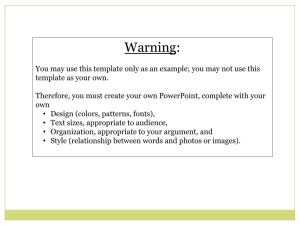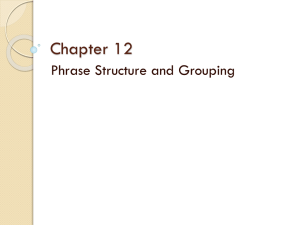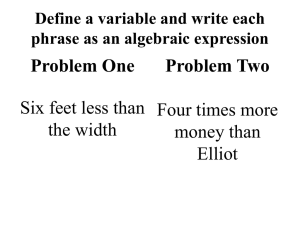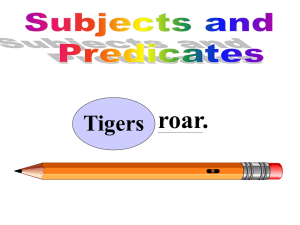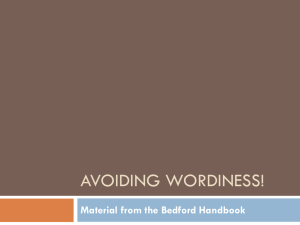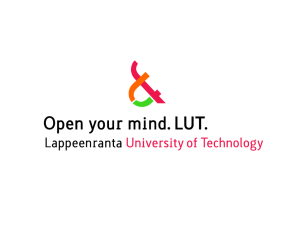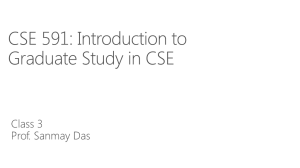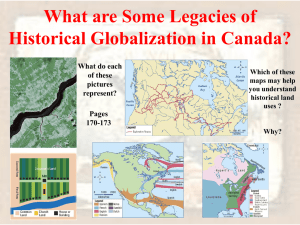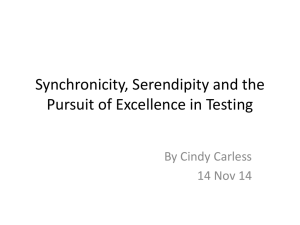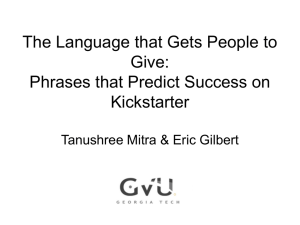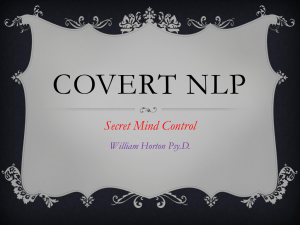Clustering to Find Exemplar Terms for Keyphrase Extraction
advertisement
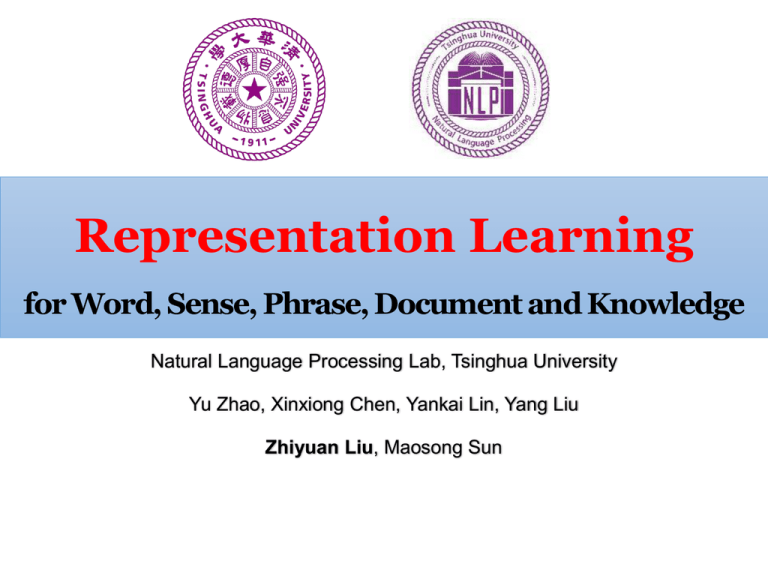
Representation Learning for Word, Sense, Phrase, Document and Knowledge Natural Language Processing Lab, Tsinghua University Yu Zhao, Xinxiong Chen, Yankai Lin, Yang Liu Zhiyuan Liu, Maosong Sun Contributors Yu Zhao Xinxiong Chen Yankai Lin Yang Liu ML = Representation + Objective + Optimization Good Representation is Essential for Good Machine Learning Representation Learning Machine Learning Systems Raw Data Yoshua Bengio. Deep Learning of Representations. AAAI 2013 Tutorial. NLP Tasks: Tagging/Parsing/Understanding Document Representation Knowledge Representation Phrase Representation Sense Representation Word Representation Unstructured Text NLP Tasks: Tagging/Parsing/Understanding Document Representation Knowledge Representation Phrase Representation Sense Representation Word Representation Unstructured Text Typical Approaches for Word Representation • 1-hot representation: basis of bag-of-word model star [0, 0, 0, 0, 0, 0, 0, 0, 1, 0, 0, 0, 0, …] sun [0, 0, 0, 0, 0, 0, 0, 1, 0, 0, 0, 0, 0, …] sim(star, sun) = 0 Typical Approaches for Word Representation • Count-based distributional representation Distributed Word Representation • Each word is represented as a dense and real-valued vector in a low-dimensional space Typical Models of Distributed Representation Neural Language Model Yoshua Bengio. A neural probabilistic language model. JMLR 2003. Typical Models of Distributed Representation word2vec Tomas Mikolov et al. Distributed representations of words and phrases and their compositionality. NIPS 2003. Word Relatedness Semantic Space Encode Implicit Relationships between Words W(‘‘China“) − W(‘‘Beijing”) ≃ W(‘‘Japan“) − W(‘‘Tokyo") Applications: Semantic Hierarchy Extraction Fu, Ruiji, et al. Learning semantic hierarchies via word embeddings. ACL 2014. Applications: Cross-lingual Joint Representation Zou, Will Y., et al. Bilingual word embeddings for phrase-based machine translation. EMNLP 2013. Applications: Visual-Text Joint Representation Richard Socher, et al. Zero-Shot Learning Through Cross-Modal Transfer. ICLR 2013. Re-search, Re-invent word2vec ≃ MF Neural Language Models Distributional Representation SVD Levy and Goldberg. Neural word embedding as implicit matrix factorization. NIPS 2014. NLP Tasks: Tagging/Parsing/Understanding Document Representation Knowledge Representation Phrase Representation Sense Representation Word Representation Unstructured Text Word Sense Representation Apple Sense disambiguation via clus Multiple Prototype Methods words and words tely modular, and od with any tradi- ... chose Zbigniew Brzezinski for the position of ... ... thus the symbol s position on his clothing was ... ... writes call options against the stock position ... ... offered a position with ... ... a position he would hold until his retirement in ... ... endanger their position as a cultural group... ... on the chart of the vessel s current position ... ... not in a position to help... (cluster#1) location importance bombing (cluster#2) post appointme nt, role, job arisons to human for both isolated (cluster#3) single ntext. The results prototype intensity, winds, ustered approach hour, gust d exemplar-based (cluster#4) e, given the isolineman, tackle, role, hod produces the scorer using a single pro(collect contexts) (cluster) (similarity) word cell in the ed while Piasecki Figure 1: Overview of the multi-prototype approach J. Reisinger and R. Mooney. Multi-prototype vector-space models of word meaning. HLT-NAACL 2010. s Edelivered toImproving his Huang, et al. word representations via global context and multiple word prototypes. ACL 2012. • • Nonparametric Methods Neelakantan et al. Efficient Non-parametric Estimation of Multiple Embeddings per Word in Vector Space. EMNLP 2014. Joint Modeling of WSD and WSR WSD WSR Jobs Founded Apple Chen Xinxiong, et al. A Unified Model for Word Sense Representation and Disambiguation. EMNLP 2014. Joint Modeling of WSD and WSE Joint Modeling of WSD and WSE WSD on Two Domain Specific Datasets NLP Tasks: Tagging/Parsing/Understanding Document Representation Knowledge Representation Phrase Representation Sense Representation Word Representation Unstructured Text Phrase Representation • For high-frequency phrases, learn phrase representation by regarding them as pseudo words: Log Angeles log_angeles • Many phrases are infrequent and many new phrases generate • We build a phrase representation from its words based on the semantic composition nature of languages Semantic Composition for Phrase Represent. + neural network neural network Semantic Composition for Phrase Represent. Heuristic Operations Tensor-Vector Model Zhao Yu, et al. Phrase Type Sensitive Tensor Indexing Model for Semantic Composition. AAAI 2015. Semantic Composition for Phrase Represent. Model Parameters Visualization for Phrase Representation NLP Tasks: Tagging/Parsing/Understanding Document Representation Knowledge Representation Phrase Representation Sense Representation Word Representation Unstructured Text ality, what this means is that at each iteration of gradient descent, we sample a text window, th a random word from the text window and form cation task given the Paragraph Vector. This te shown in Figure 3. We name this version the Bag of Words version of Paragraph Vector (PV-D opposed to Distributed Memory version of Para tor (PV-DM) in previous section. Document as Symbols for DR Figure 3. Distributed Bag of Words version of paragr In this version, the paragraph vector is trained to predi in a small window. In addition to being conceptually simple, this takes as input the embedding of words (often trained beforehand w he sentence aligned sequentially, and summarize the meaning of a olutionSemantic and pooling, until reachingfor a fixed Composition DR:length CNNvectorial represent most convolutional models [11, 1], we use convolution units with a ed weights, but we design a large feature map to adequately model t tion of words. over all architecture of the convolutional sentence model. A box w ero padding turned off by the gating function (see top of Page 3). Semantic Composition for DR: RNN Topic Model • Collapsed Gibbs Sampling • Assign each word in a document with an approximately topic Topical Word Representation Liu Yang, et al. Topical Word Embeddings. AAAI 2015. NLP Tasks: Tagging/Parsing/Understanding Document Representation Knowledge Representation Phrase Representation Sense Representation Word Representation Unstructured Text Knowledge Bases and Knowledge Graphs • Knowledge is structured as a graph • Each node = an entity • Each edge = a relation • A relation = (head, relation, tail): • head = subject entity • relation = relation type • tail = object entity • Typical knowledge bases • WordNet: Linguistic KB • Freebase: World KB Research Issues • KG is far from complete, we need relation extraction • Relation extraction from text: information extraction • Relation extraction from KG: knowledge graph completion • Issues: KGs are hard to manipulate • High dimensions: 10^5~10^8 entities, 10^7~10^9 relation types • Sparse: few valid links • Noisy and incomplete • How: Encode KGs into low-dimensional vector spaces Typical Models - NTN Neural Tensor Network (NTN) Energy Model TransE: Modeling Relations as Translations • For each (head, relation, tail), relation works as a translation from head to tail TransE: Modeling Relations as Translations • For each (head, relation, tail), make h + r = t Link Prediction Performance On Freebase15K: The Issue of TransE • Have difficulties for modeling many-to-many relations Modeling Entities/Relations in Different Space • Encode entities and relations in different space, and use relation-specific matrix to project Lin Yankai, et al. Learning Entity and Relation Embeddings for Knowledge Graph Completion. AAAI 2015. Modeling Entities/Relations in Different Space • For each (head, relation, tail), make h x W_r + r = t x W_r head relation + tail = Cluster-based TransR (CTranR) Evaluation: Link Prediction Which genre is the movie WALL-E? WALL-E _has_genre ? Evaluation: Link Prediction Which genre is the movie WALL-E? WALL-E _has_genre Animation Computer animation Comedy film Adventure film Science Fiction Fantasy Stop motion Satire Drama Connecting Performance Research Challenge: KG + Text for RL • Incorporate KG embeddings with text-based relation extraction Power of KG + Text for RL Research Challenge: Relation Inference • Current models consider each relation independently • There are complicate correlations among these relations predecessor predecessor predecessor father father grandfather NLP Tasks: Tagging/Parsing/Understanding Document Representation Knowledge Representation Phrase Representation Sense Representation Word Representation Unstructured Text Take Home Message • Distributed representation is a powerful tool to model semantics of entries in a dense low-dimensional space • Distributed representation can be used • as pre-training of deep learning • to build features of machine learning tasks, especially multi-task learning • as a unified model to integrate heterogeneous information (text, image, …) • Distributed representation has been used for modeling word, sense, phrase, document, knowledge, social network, text/images, etc.. • There are still many open issues • Incorporation of prior human knowledge • Representation of complicated structure (trees, network paths) Everything Can be Embedded (given context). (Almost) Everything Should be Embedded. Publications • Xinxiong Chen, Zhiyuan Liu, Maosong Sun. A Unified Model for Word Sense Representation and Disambiguation. The Conference on Empirical Methods in Natural Language Processing (EMNLP'14). • Yu Zhao, Zhiyuan Liu, Maosong Sun. Phrase Type Sensitive Tensor Indexing Model for Semantic Composition. The 29th AAAI Conference on Artificial Intelligence (AAAI'15). • Yang Liu, Zhiyuan Liu, Tat-Seng Chua, Maosong Sun. Topical Word Embeddings. The 29th AAAI Conference on Artificial Intelligence (AAAI'15). • Yankai Lin, Zhiyuan Liu, Maosong Sun, Yang Liu, Xuan Zhu. Learning Entity and Relation Embeddings for Knowledge Graph Completion. The 29th AAAI Conference on Artificial Intelligence (AAAI'15). Thank You! More Information: http://nlp.csai.tsinghua.edu.cn/~lzy Email: liuzy@tsinghua.edu.cn
